Growing And Harvesting Sweetcorn In The Garden – ‘Only Grow One Variety Each Year’

VEGETABLES > SWEETCORN
Chris is a gardening writer and nature enthusiast. He graduated from Oxford Brookes University in 2022 with an MA in Psychology. Chris works with the Leeds Green Action Society, helping their food cooperative by growing various fruit and vegetables on their two allotments in Hyde Park, Leeds.
Reviewed By PETER LICKORISH

Peter is a Horticulture Lecturer and self-employed Horticulturist, with a passion for diverse areas of the industry - from garden design to the science behind plant growth and propagation. He has completed the Royal Horticultural Society’s Master of Horticulture (MHort) Award and lectures on RHS courses at Bedford College.
Contributions From JENNY THOMPSON

Jenny Thompson, known online as Organic Allotment Girl, is an allotment grower, blogger and is currently an Assistant Kitchen Gardener at The Riverford Field Kitchen in Dartmoor. She has her own flower farm and provides cuts and dried bouquets to her customers. Jenny holds a Permaculture Design Certificate from the Apricot Centre in Totnes.

Janice Shipp is a Writer with 15 years' experience as Principal Researcher for Which? Gardening magazine. She has received her RHS MHort and City and Guilds Planting Design qualifications and is a member of the RHS Herbaceous Plant Committee. Janice is also a member of both the Garden Media Guild and Chartered Institute of Horticulture - and was Chair of forum on a Penstemon trial for the Royal Horticultural Society.
SWEETCORN GUIDES
Sweet corn is a yellow vegetable, and the word refers both to the cob, and the kernels that grow on it.
Dig a little below the surface-level and the properties of sweet corn are actually quite interesting.
This crop is a variety of grain maize, known for its particularly high sugar content arising from a natural genetic mutation that encourages the production of more sugar.1Sweet corn growing. (n.d.). NSW Government. Retrieved March 14, 2023, from https://www.dpi.nsw.gov.au/agriculture/horticulture/vegetables/commodity-growing-guides/sweet-corn
This means that humans have evolved to pick corn before it reaches full maturity and eat it as a vegetable, rather than letting it mature into a grain.2Is corn a grain or a vegetable? (n.d.). AskUSDA. Retrieved March 14, 2023, from https://ask.usda.gov/s/article/Is-corn-a-grain-or-a-vegetable
“Sweetcorn is a big favourite of mine when it comes to vegetables because it tastes so good fresh from the garden,” says Garden Writer Janice Shipp.
Overview
| Botanical Name | Zea mays |
| Common Name(s) | Corn |
| Plant Type | Vegetable / Annual |
| Native Area | Americas |
| Hardiness Rating | H2 |
| Foliage | Annual blade-shaped leaves |
| Flowers | Tassels |
| When To Sow Indoors | April, May |
| Plant Out | June, July |
| Harvesting Months | July, August, September, October |
Sunlight
Preferred
Full Sun
Exposure
Sheltered (requires protection in colder areas)
Size
Height
1 – 2.5M
Spread
0.1 – 0.5M
Bloom Time
Summer
Soil
Preferred
Most fertile soils
Moisture
Moist yet free draining
pH
Any
A grilled corn on the cob with a crack of salt and a coating of melted butter is amongst the most satisfying and enjoyable dishes we can think of.
Using a corn you’ve grown yourself, with its especially sweet and delicious flavour, takes the dish to another level.
“One of my favourite things I have growing right now is sweetcorn,” shares Jenny Thompson, Allotment Grower.
“I am pretty good at growing it too!
“However, I only grow one variety each year, as sweetcorns are wind pollinated and if you have different varieties near each other, they are likely to cross-pollinate and produce something different to what you were expecting.”
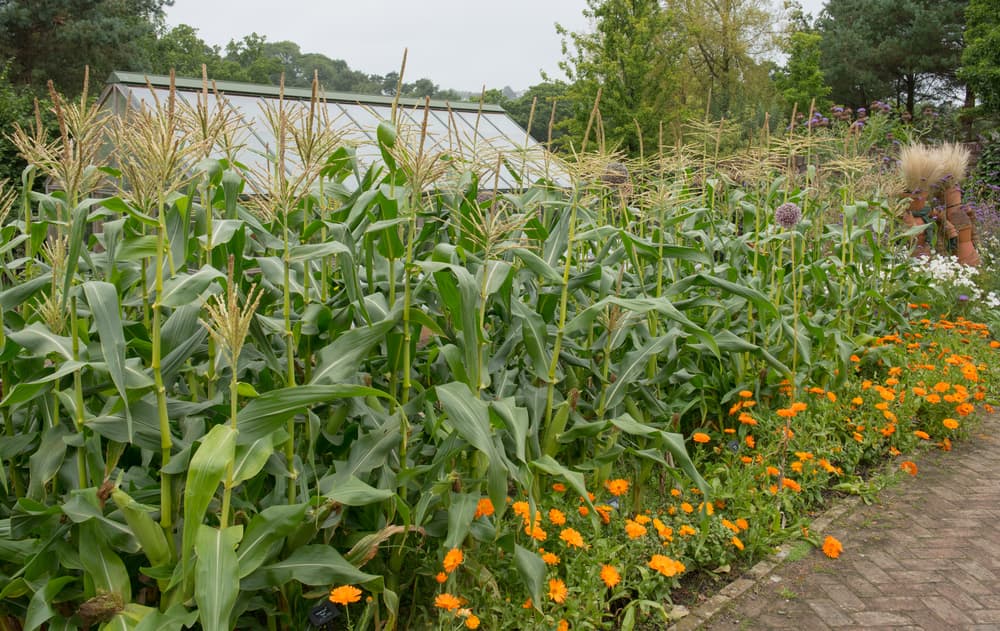
Corn’s tall and distinctive aesthetic makes an attractive addition to your garden, and the crop offers flexibility in the number of varieties available.
Taking time to choose the right variety lets you grow corn whose flavour profile best aligns with your palette.
“Sweet corns are fascinating plants and they can do some seemingly odd things, but these have perfectly simple explanations,” shares Horticulturist Peter Lickorish.
“Firstly, roots are likely to jut out from above ground, near the base of the plant. It is a widely accepted view that these prop roots are there to provide additional support to tall plants as braces against windy conditions.
“Also, sweetcorn cobs may sometimes appear gappy, like a toddler’s set of teeth.
“This is a sign that there is poor pollination, so consider growing more plants in a grid layout next year.”
How To Grow Sweetcorn
In the sections below we provide step-by-step information on how to grow your own bumper crop of sweet corn.
While you may be used to seeing fields upon fields of corn growing, it’s also possible to grow a few plants in your garden – so don’t be put off if you don’t have much space!
Where To Grow
Before planting your corn, find a good spot and enrich the soil with compost or other organic matter.
Dig this through the soil well to maximise the nutrients available to the corn, potentially even adding a fertiliser that’s high in potassium.
Corn grows best in a spot that gets plenty of sunshine, and while they require wind to assist with pollination, try to choose somewhere that’s sheltered from the worst of the elements.
You want your corns exposed to a gentle and regular breeze rather than strong winds that can build up speed in open spots.
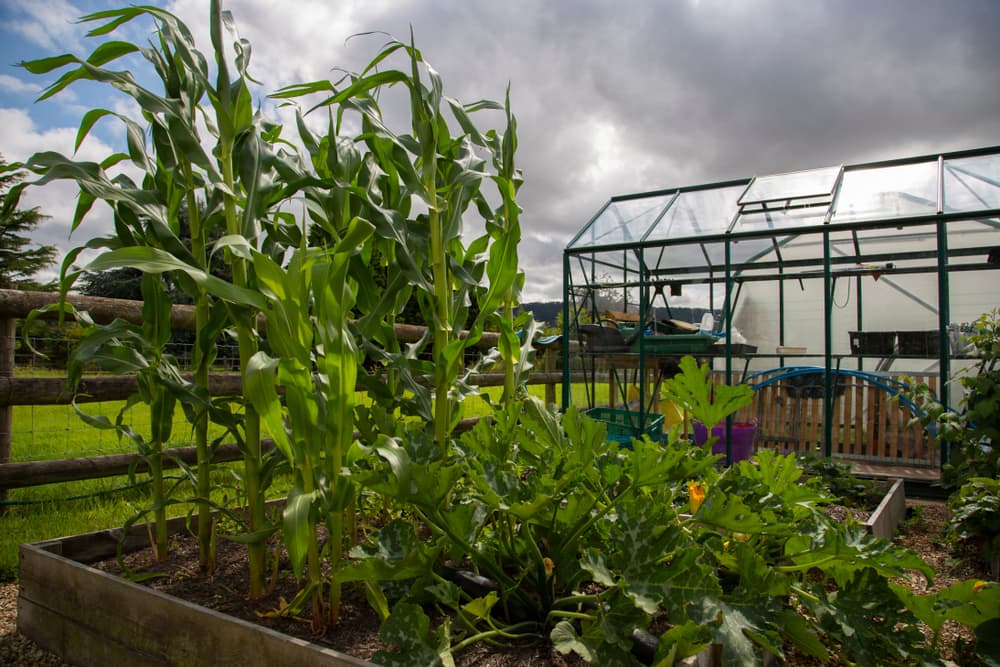
“I plant my cobs in grid formation to aid the chance of good pollination but I don’t leave pollination to chance,” says Jenny.
“Once the tassel on the top of the plant appears, I pick one off and tickle all the silks with it, thereby transferring pollen to where it needs to be.
“Incredibly, each individual silk is attached to one individual kernel and each silk must receive a grain of pollen for that kernel to be fertilised.
“Ever peeled back a home-grown cob only to find some plump yellow kernels and some gnarly pale-looking ones? The gnarly ones didn’t get pollinated, so trust me, tassel tickling is the way to go.”
If you’re growing squash you can also grow your sweet corn amongst it, as the two plants complement each other well by taking different things from the soil.
Native American farmers were renowned for growing ‘three sisters’, which is corn, squash, and beans grown in a symbiotic arrangement.3The Three Sisters of Indigenous American Agriculture. (n.d.). National Agricultural Library. Retrieved March 14, 2023, from https://www.nal.usda.gov/collections/stories/three-sisters
If you’re feeling particularly adventurous you could try out this method!
Sowing
For best results, sow your sweet corn seeds into pots in a greenhouse or a cold frame or similar.
Doing so gives you a head start when compared to sowing directly outdoors, as you can shelter the seedlings from harsher temperatures.
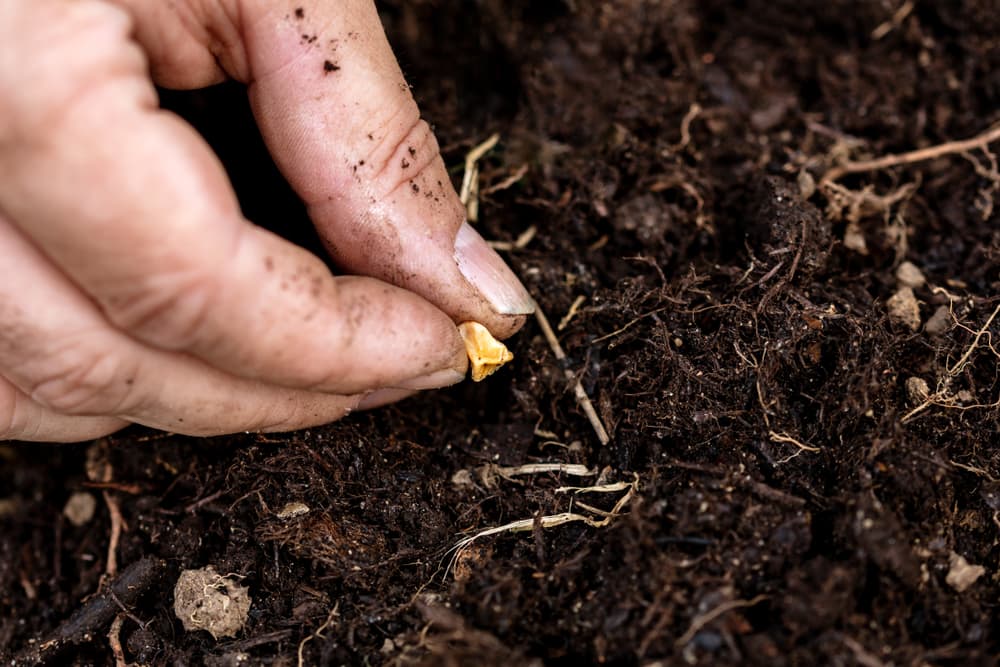
If you decide to sow this way you can begin growing your corn around a month before the last frost!
“This will usually be from early April, but it is worth considering in colder springs that they will need around 18°C to germinate,” adds Peter.
Pop some soil into small containers, then push seeds an inch down below the surface.
Corn is not fussy with soil types: any potting compost should do the trick.
Sow two seeds beside each other, then remove the weaker seedling before the next step.
Planting Out
Once your corns are about six inches high, they’re strong enough to make the transition outdoors.
Ideally you’d harden them off before planting them out, and doing this is easy.
Just leave the plants outside for short periods of time in the week before you plan to plant them, with the periods gradually getting longer.

If you’ve got a cold frame this is the perfect space for hardening off corn.
While many crops grow best in rows, we recommend planting out corn in blocks using a grid layout, as this gives it the best chance at pollination.
Corn is pollinated by wind, and placement in a block increases the spores’ chance to spread.
If your crops aren’t able to pollinate enough they’ll still grow, but you’ll have fewer cobs.
Look to plant your corns about 18 inches from each other in all directions.
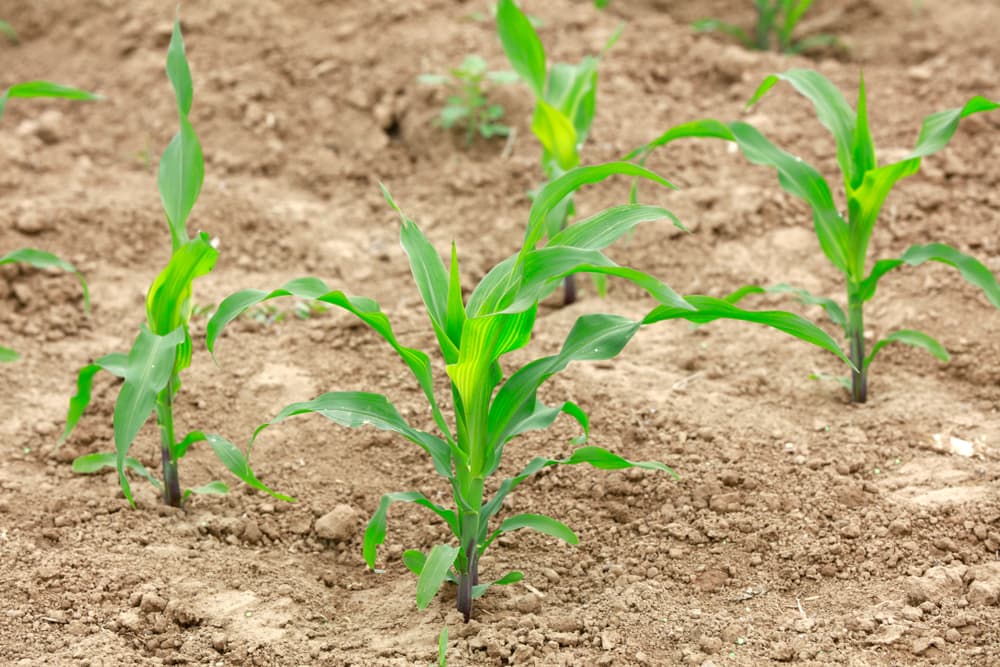
To plant, remove from the pot, tussle the roots to loosen everything up, then pop into individual holes.
Once a corn is in its hole, firm up the soil around the base of each plant to keep it secure.
Ongoing Plant Care
Fertilising
As well as preparing the soil before planting your corn, we advise on mulching the soil at the base of your plant with garden compost while growing.
This will help to retain moisture and to reduce weed coverage.
“Doing this with fresh garden compost, at the end of a damp spell of weather, is particularly effective,” says Peter.
Watering
In dry weather make sure to water your corn plants frequently.
This is especially important when the plants are flowering, as this is when they’re at their thirstiest.
Weeding
Corn is just as prone to weeds as any other plant, although hopefully mulching should help to reduce their number.

If you use a hoe to help with your weeding, go carefully.
Corn has shallow roots and hoeing too aggressively can damage the crop along with the weeds.
Harvesting
Corn is ready for harvesting when its tassels turn brown and darken.
This usually occurs a few weeks after they initially appear.
The physical act of harvesting is quite easy: either pull or twist the corn away from the stem. If pulling isn’t working, a gentle twist should help.
To test whether your corn is ready, there’s a test you can do before removing the cob from the plant:
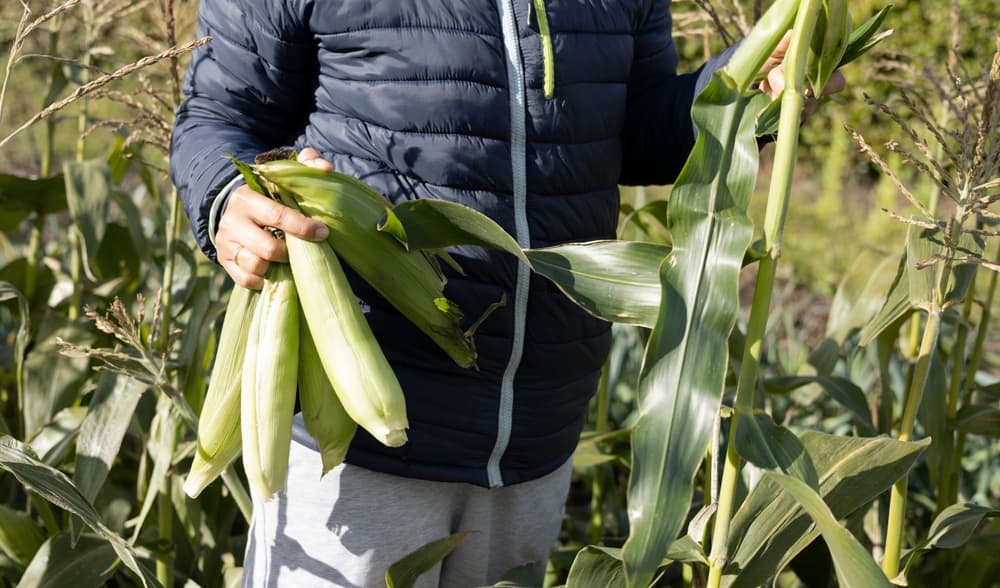
Simply peel back part of the sheath and press a fingernail into a kernel.
- If the liquid inside is creamy in colour, the corn is ready to go.
- If the liquid is watery it’s not quite ready yet.
- And if there’s no liquid you’ve left it too late!
Once harvested, remove the sheaths from your cobs and cook as soon as possible.
Many gardeners swear that the best taste is achieved by cooking almost instantly after harvest.
If you’re not planning to eat it immediately however, we recommend refrigerating before removing the sheaths.
“It is also important not to prune the tops of sweetcorn plants, as this is where the male flowers form, which pollinate the female flowers lower down, to form cobs,” says Peter.
Common Problems
Sadly, corn is very appealing to all manner of garden pests including mice, birds, and creepy crawlies.
Here’s how to deal with some of these pesky visitors:
Mice
“To keep mice off of seeds until they’ve germinated, consider using a mesh, such as that used to bag oranges,” says Peter.
“This can form a sock around the pot to keep hungry mammals at bay.”
Birds
While you don’t want to catch birds in a mousetrap, you do want to deter them from eating your corns.
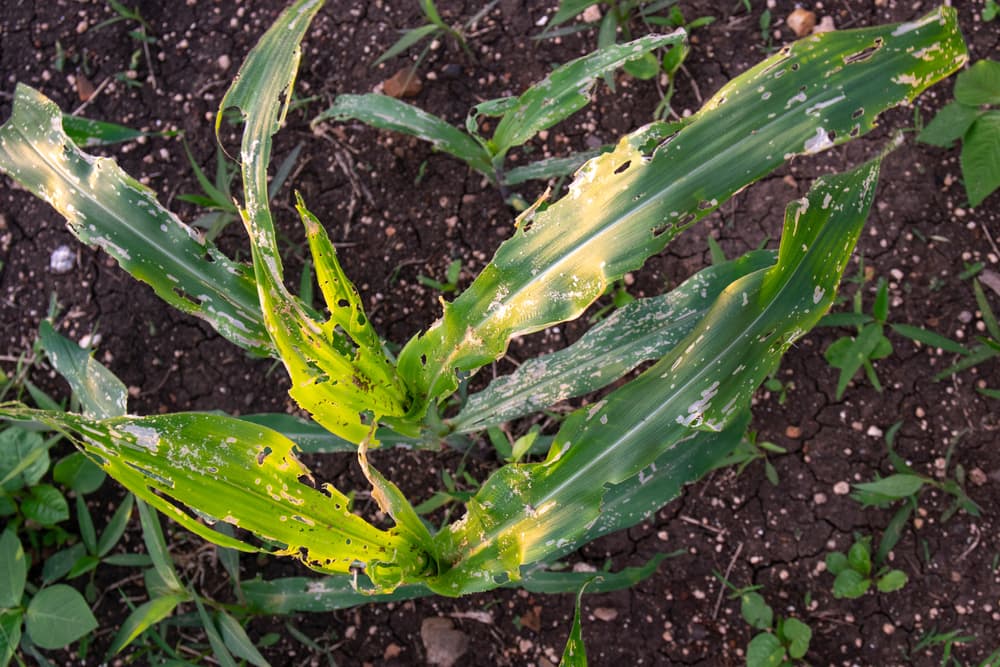
The best way to stop these flying critters from ravaging your crop is to cover it with a material that lets in air and sunlight but keeps out beaks.
Fleece or mesh are good bets.
Slugs & Snails
Whatever you’re growing, it’s likely you’ll have to contend with these menaces.
There are many ways to deter them including sacrificial crops designed to distract them and other less savoury solutions!
We hope that this guide has been helpful in showing you just how easy corn is to grow, and we hope that you’ll soon be enjoying the fruits of your industry.
References
- 1Sweet corn growing. (n.d.). NSW Government. Retrieved March 14, 2023, from https://www.dpi.nsw.gov.au/agriculture/horticulture/vegetables/commodity-growing-guides/sweet-corn
- 2Is corn a grain or a vegetable? (n.d.). AskUSDA. Retrieved March 14, 2023, from https://ask.usda.gov/s/article/Is-corn-a-grain-or-a-vegetable
- 3The Three Sisters of Indigenous American Agriculture. (n.d.). National Agricultural Library. Retrieved March 14, 2023, from https://www.nal.usda.gov/collections/stories/three-sisters
